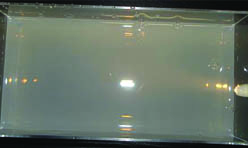
Milk Fat LabIntroductionAccording to Beer’s Law the percent of light that passes through a liquid medium is related to the medium’s thickness, color, and concentration. When the thickness and color of the media is kept constant, the quality of the light coming out of the medium should directly correlate to the concentration of particles in the medium. The purpose of this investigation is to demonstrate Beer’s Law using milky water and see how well light is scattered by the fat globules that become suspended in the water as a result. HypothesisAs more milk fat is added to the water, the light passing through it will become dimmer because there will be more particles to scatter the light. Thus, the spot light on the paper will become smaller and a beam of light will become visible through the media. Procedure:
1. Fill one 2 Liter tank completely with water. ObservationsBefore the milk fat was added, the light clearly transmitted through the tank; the paper had a spot of light that was bright and big. When milk was added to the tank, the fat globules scattered the light. The low transmittance of the light meant a high concentration of milk fat. Did you knowWhy is the sky blue? |
|
Any opinions, findings, and conclusions or recommendations expressed in this material are those of the author(s) and do not necessarily reflect the views of the National Science Foundation. Institute for Systems Biology, 1441 North 34th Street, Seattle, WA 98103-8904 |
 2. On one end of the tank place a piece of white paper, and on the other end place a flashlight.
2. On one end of the tank place a piece of white paper, and on the other end place a flashlight. 